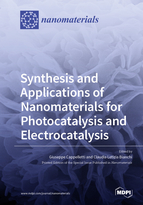Synthesis and Applications of Nanomaterials for Photocatalysis and Electrocatalysis
A special issue of Nanomaterials (ISSN 2079-4991).
Deadline for manuscript submissions: closed (30 October 2018) | Viewed by 67963
Special Issue Editors
Interests: surface modification and functionalization; wettability; nanomaterials; thin layer; cultural heritage protection; colloids and interfaces; photocatalysis and VOC sensing; advanced oxidation processes for environmental remediation; formulation technology
Special Issues, Collections and Topics in MDPI journals
Interests: process intensification; photocatalysis; ultrasound; advanced materials synthesis; gas and liquid phase reactors
Special Issues, Collections and Topics in MDPI journals
Special Issue Information
Dear Colleagues,
Heterogeneous catalysis, exploiting photo- and electro-chemical reactions, has expanded rapidly in the last few decades, having undergone various developments, especially from the energetic and the environmental points of view. Photocatalysis plays a pivotal role in applications, such as water splitting and air/water remediation. Electrocatalysis can be found in a large array of research fields, including the development of electroanalytical sensors, waste water treatment and energy conversion devices (e.g., batteries, fuel and solar cells, etc.). Therefore, the fine control of the synthetic procedures, together with extensive physico-chemical characterizations of the tailored-made catalytic nanomaterials, are of fundamental importance to reach desired results.
The present Special Issue of Nanomaterials will include recent enhancements in the oxide/metal nanoparticles for photocatalytic and electrocatalytic applications, especially in the fields of pollutants abatement and energy conversion.
Prof. Giuseppe CappellettiProf. Claudia L. Bianchi
Guest Editors
Manuscript Submission Information
Manuscripts should be submitted online at www.mdpi.com by registering and logging in to this website. Once you are registered, click here to go to the submission form. Manuscripts can be submitted until the deadline. All submissions that pass pre-check are peer-reviewed. Accepted papers will be published continuously in the journal (as soon as accepted) and will be listed together on the special issue website. Research articles, review articles as well as short communications are invited. For planned papers, a title and short abstract (about 100 words) can be sent to the Editorial Office for announcement on this website.
Submitted manuscripts should not have been published previously, nor be under consideration for publication elsewhere (except conference proceedings papers). All manuscripts are thoroughly refereed through a single-blind peer-review process. A guide for authors and other relevant information for submission of manuscripts is available on the Instructions for Authors page. Nanomaterials is an international peer-reviewed open access semimonthly journal published by MDPI.
Please visit the Instructions for Authors page before submitting a manuscript. The Article Processing Charge (APC) for publication in this open access journal is 2900 CHF (Swiss Francs). Submitted papers should be well formatted and use good English. Authors may use MDPI's English editing service prior to publication or during author revisions.
Keywords
- water and air photocatalytic remediation
- energy conversion (e.g., batteries, fuel cells and solar cells, photovoltaic devices)
- synthesis of nanomaterials
- bulk/surface characterizations








